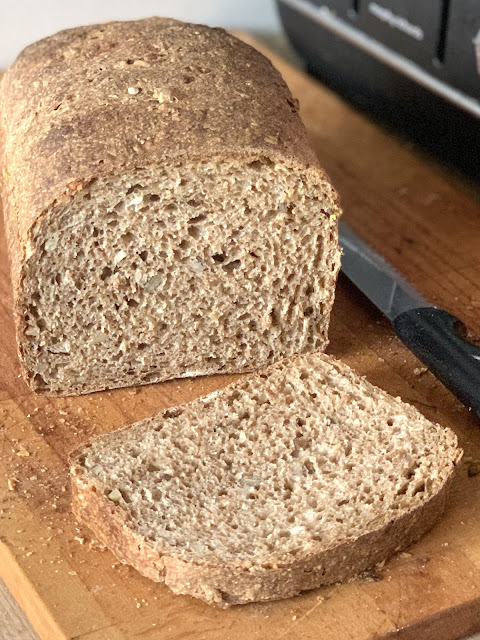Wholegrain sourdough does not have the big cosmetic 'holes' that have become associated with artisan'white sourdough. Instead it is a dense, filling, high fibre bread.
I sell homemade white sourdough, but have begun making this wholegrain sourdough loaf for my partner and I. As with sourdough, it is a lengthy process, but it is mostly hands off and requires no tricky shaping or turning out. If you don't have any sourdough starter you could have your own homegrown starter in 5 days, and sourdough on your New Year's resolutions.
Makes 1 large or 2 small loaves
Preparation time: 36 hours (hands on time about 30 minutes in total)
Cooking time: 1 hour
Preparation time: 36 hours (hands on time about 30 minutes in total)
Cooking time: 1 hour
300g active sourdough starter
250g wholemeal flour
250g wholegrain flour (I use Sainsbury's Wholegrain Seeded Flour, but intend experimenting with varying quantities of wholemeal rye flour, malted flour, spelt flour)
25g mixed seeds
10g salt
300g warm water
I have based the timings of this loaf around a working day, and baking the loaf first thing in the morning.
Two nights before (36 hours before) you want to bake the loaf, take the starter out of the fridge and leave on the counter to warm up.
The following morning (8am - 24 hours before), feed your starter with 50/50 wholemeal flour and water to make 300g starter plus about 20g to keep back as reserved starter. Leave the starter on the counter throughout the day.
Late afternoon (5-6pm - 4 hours before you go to bed), weigh out 300g of starter into a large mixing bowl. Whisk in the water with a fork, and then stir in the rest of the ingredients. Mix well with the fork then use your hand to ensure everything comes together. You should have a sticky but stiff dough. Wholemeal flour absorbs more water than white bread flour so you may need to add more water to make a workable dough that you can push your fingers into with some force but holds it shape when folded into a ball.
Cover with a clean tea towel and leave somewhere warm like near a radiator, in the airing cupboard or in a sunny window.
Every hour for the next 4 hours, with a wet hand, stretch and fold the dough in half onto itself, top down, bottom up, left to right, and right to left. Recover and leave for another hour.
After the final stretch and fold, tip out onto a lightly floured surface, stretch out to a rectangle and then roll up like a Swiss roll to a sausage shape to fit in a loaf tin lined with greaseproof paper.
Loosely cover with a large plastic bag, with enough room for the loaf to rise without touching the plastic, and leave to rise overnight in a cool place. I've begun making this in winter, so leaving the loaf to rise in the kitchen overnight with the heating off has been perfect. In summer I may have leave it in the fridge overnight if it rises too much, although wholegrain flours don't rise as much as white so this loaf may never overflow it's loaf tin.
The following morning preheat your oven to 230C. Once up to temperature, place the loaf in it's tin on the middle shelf and bake for 20 minutes at 230C and 20 minutes at 200C.
After 20 minutes at 200C, tip the loaf out of the loaf tin and remove the greaseproof paper.
Turn the oven down to 180C and bake for a final 20 minutes.
Baking lore advises to wait a couple of hours for loaves to cool to body temperature before slicing. I'm not entirely sure why. From experience hot/warm loaves are harder to slice, with the bread often tearing. But the urge to taste a freshly baked loaf is hard to resist...

No comments:
Post a Comment